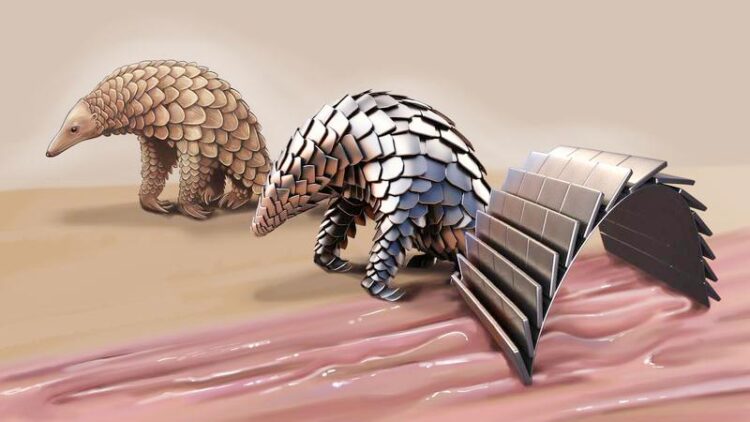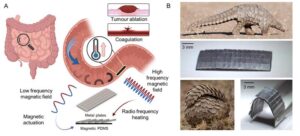Pangolin the inspiration for medical robot

Pangolin the inspiration for medical robot
(c) MPI-IS
Robot is made of metal and yet is soft and flexible.
Scientists at the Max Planck Institute for Intelligent Systems in Stuttgart have developed a magnetically controlled soft medical robot with a unique, flexible structure inspired by the body of a pangolin. The robot is freely movable despite built-in hard metal components. Thus, depending on the magnetic field, it can adapt its shape to be able to move and can emit heat when needed, allowing for functionalities such as selective cargo transportation and release as well as mitigation of bleeding. The research will be published in Nature Communications on 20 June 2023.

Fig. 1 shows the pangolin-inspired untethered magnetic robot. A Conceptual illustration of the pangolin-inspired robot operating in the small intestine. Robot is actuated with a low-frequency magnetic field and heated with a high-frequency magnetic field
(c) MPI-IS
Pangolins are fascinating creatures. This animal looks like a walking pine cone, as it is the only mammal completely covered with hard scales. The scales are made of keratin, just like our hair and nails. The scales overlap and are directly connected to the underlying soft skin layer. This special arrangement allows the animals to curl up into a ball in case of danger.
While pangolins have many other unique features, researchers from the Physical Intelligence Department at the Max Planck Institute for Intelligent Systems in Stuttgart, which is led by Prof. Dr. Metin Sitti, were particularly fascinated by how pangolins can curl up their scale-covered bodies in a flash. They took the animal as a model and developed a flexible robot made of soft and hard components that, just like the animal, become a sphere in the blink of an eye – with the additional feature that the robot can emit heat when needed.
In a research paper to be published in Nature Communications on 20 June 2023, first author Ren Hao Soon and his colleagues present a robot design that is no more than two centimeters long and consists of two layers: a soft layer made of a polymer studded with small magnetic particles and a hard component made of metal elements arranged in overlapping layers. Thus, although the robot is made of solid metal components, it is still soft and flexible for use inside the human body.
When the robot is exposed to a low-frequency magnetic field, the researchers can roll up the robot and move it back and forth as they wish. The metal elements stick out like the animal’s scales, without hurting any surrounding tissue. Once it is rolled up, the robot can transport particles such as medicines. The vision is that such a small machine will one day travel through our digestive system, for example.
Double useful: freely movable and hot
When the robot is exposed to a high-frequency magnetic field, it heats up to over 70oC thanks to the built-in metal. Thermal energy is used in several medical procedures, such as treating thrombosis, stopping bleeding and removing tumor tissue. Untethered robots that can move freely, even though they are made of hard elements such as metal and can also emit heat, are rare. The pangolin robot is therefore considered promising for modern medicine. It could one day reach even the narrowest and most sensitive regions in the body in a minimally invasive and gentle way and emit heat as needed. That is a vision of the future. Already today, in a video, the researchers are showing how they can flexibly steer the robot through animal tissue and artificial organs.
Please find the images, graphic and the video in this Dropbox:
https://www.dropbox.com/sh/q3uli3t6cg7lizc/AADimpeA_yH3ha9lc8oBCVsCa?dl=0
Copyright: MPI for Intelligent Systems.
The DOI number for this paper will be 10.1038/s41467-023-38689-x. Once the paper has been published online, it will be available at the following URL:
https://www.nature.com/articles/s41467-023-38689-x
Wissenschaftliche Ansprechpartner:
Prof. Dr. Metin Sitti
sitti@is.mpg.de
Originalpublikation:
The DOI number for this paper will be 10.1038/s41467-023-38689-x. Once the paper has been published online, it will be available at the following URL:
https://www.nature.com/articles/s41467-023-38689-x
Weitere Informationen:
Please find the images, graphic and the video in this Dropbox:
https://www.dropbox.com/sh/q3uli3t6cg7lizc/AADimpeA_yH3ha9lc8oBCVsCa?dl=0
Copyright: MPI for Intelligent Systems
https://is.mpg.de/news/pangolin-the-inspiration-for-medical-robot
Media Contact
All latest news from the category: Medical Engineering
The development of medical equipment, products and technical procedures is characterized by high research and development costs in a variety of fields related to the study of human medicine.
innovations-report provides informative and stimulating reports and articles on topics ranging from imaging processes, cell and tissue techniques, optical techniques, implants, orthopedic aids, clinical and medical office equipment, dialysis systems and x-ray/radiation monitoring devices to endoscopy, ultrasound, surgical techniques, and dental materials.
Newest articles

Innovative 3D printed scaffolds offer new hope for bone healing
Researchers at the Institute for Bioengineering of Catalonia have developed novel 3D printed PLA-CaP scaffolds that promote blood vessel formation, ensuring better healing and regeneration of bone tissue. Bone is…

The surprising role of gut infection in Alzheimer’s disease
ASU- and Banner Alzheimer’s Institute-led study implicates link between a common virus and the disease, which travels from the gut to the brain and may be a target for antiviral…

Molecular gardening: New enzymes discovered for protein modification pruning
How deubiquitinases USP53 and USP54 cleave long polyubiquitin chains and how the former is linked to liver disease in children. Deubiquitinases (DUBs) are enzymes used by cells to trim protein…



